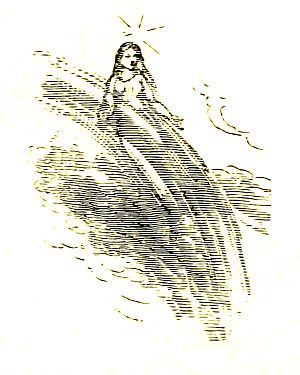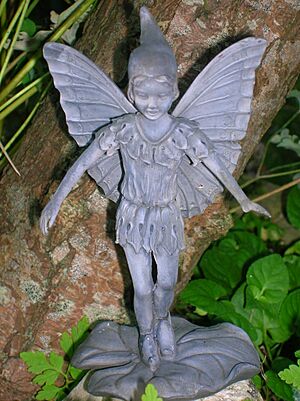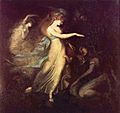Fairy facts for kids
A fairy is a magical creature often imagined as flying through the air. They are usually shown as small girls or women. Some fairies have special jobs, like the Tooth fairy, who brings money or treats when a child's tooth falls out. A fairy tale is a story that features fairies. These stories are usually written for children. Fairies also appear in old stories and beliefs, especially in places like Ireland and Scotland. In these tales, fairies are sometimes seen as ancient beings who now live in hidden places. Many people believe fairies are a type of angel. You can find fairies in many fictional books, such as "Peter Pan" and "The Spiderwick Chronicles".
Contents
What Does the Word "Fairy" Mean?
The word "fairy" comes from an old French word, faerie, which meant "enchantment" or "magic". It also comes from the Latin word fata. In old French stories, a "fee" was a woman who was skilled in magic and knew about the power of words, stones, and herbs.
Over time, the word faie became the modern English word fay. The word faierie became fairy. Now, "fairy" mostly refers to these legendary magical people. The word "fairy" used to mean an illusion, a magical spell, the land where fairies live, or even a group of fairies.
How Are Fairies Described?
Fairies are generally described as looking like humans and having magical powers. Stories about tiny fairies have been around for centuries, but they often appear alongside human-sized fairies. Their size can range from very small to the size of a human child. Even small fairies might be able to change their size using magic, rather than always staying tiny. Some fairies, though usually small, could grow larger to look like humans. In the Orkney Islands, fairies were described as short, dressed in dark gray, and sometimes seen wearing armor.
Wings are very common in modern pictures of fairies, especially from the Victorian era onwards. However, in older stories, wings were very rare. Even tiny fairies flew using magic, sometimes riding on ragwort stems or on the backs of birds. Today, fairies are often shown with insect or butterfly wings. In some old tales, fairies have green eyes. Some pictures show fairies wearing shoes, while others show them always barefoot.
Fairy Characteristics and Tricks
Much of the old folklore about fairies focuses on how to protect yourself from their mischief. People used things like cold iron, rowan tree charms, or special herbs. They also tried to avoid upsetting fairies by staying away from places known to be theirs.
Some of the tricks fairies played were harmless, like tangling the hair of sleeping people into "Elf-locks" or hiding small items. But some behaviors were much more dangerous. Any sudden death might have been blamed on fairies kidnapping someone, leaving a wooden copy behind. A disease called consumption (now known as tuberculosis) was sometimes blamed on fairies forcing young people to dance at parties every night, making them weak from lack of rest. Rowan trees were considered sacred to fairies.
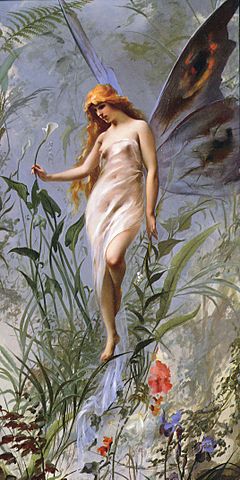
Types of Fairies
In Scottish folklore, fairies are divided into two main groups:
- The Seelie Court: These fairies were more kindly, but could still be dangerous. They enjoyed playing harmless pranks on humans.
- The Unseelie Court: These were malicious fairies who enjoyed causing harm to humans for fun.
Trooping fairies are fairies who appear in groups and might even form settlements. This term can include many different kinds of mythical creatures, especially from Celtic mythology. It might also refer to beings like dwarves or elves from German folklore. These are different from solitary fairies, who live alone and do not associate with others of their kind.
Fairy Changelings
Many old stories about fairies talk about changelings. These were fairy children left in the place of human babies that had been stolen by fairies. People had many beliefs about how to stop fairies from stealing babies or even older people. The idea of a swapped child was common in old stories. It showed worries about babies who seemed to have unexplained illnesses, disorders, or developmental problems. In the past, a family's survival often depended on everyone working. A person who was a constant drain on the family's limited resources could threaten the whole family's survival.
Protective Charms Against Fairies
People believed certain things could protect them from fairies. Wearing clothes inside out, the sound of church bells, St. John's wort plants, and four-leaf clovers were thought to be effective. In Newfoundland folklore, bread was a very popular way to protect against fairies. This could be stale bread, hard tack, or fresh homemade bread. Bread is linked to the home and cooking, and to human work, so some fairies were thought to dislike it. However, in much of Celtic folklore, baked goods, cream, and butter were traditional offerings to fairies.
Bells have a mixed role. While they protect against fairies, fairies riding horses, like the fairy queen, often have bells on their harnesses. This might show a difference between the Seelie Court and the Unseelie Court, where good fairies use bells to protect themselves from more wicked ones. Another mixed belief is about chickens: a rooster's crow was said to drive away fairies, but other tales say fairies kept chickens.
Some fairies would confuse travelers. People believed they could avoid the will o' the wisp by not following it. Certain places known to be fairy haunts were to be avoided. Digging in fairy hills was considered unwise. Paths that fairies travel were also best avoided. Homeowners sometimes knocked corners off houses if the corner blocked a fairy path. Cottages were built with front and back doors in a straight line so owners could leave them open and let fairies pass through all night. Places like fairy forts were left alone. Even cutting bushes on fairy forts was said to lead to death. Fairy trees, like thorn trees, were dangerous to cut down. One such tree in Scotland was left alone for seventy years because it was believed to be a fairy tree.
Other actions were thought to upset fairies. Brownies were known to leave if they were given clothes, though some stories say they were offended by poor quality clothes, while others say they were delighted and left with the gift. Other brownies left homes because they heard a complaint or even a compliment. People who saw fairies were advised not to look too closely, as fairies disliked having their privacy invaded. The need not to offend them could cause problems. One farmer found that fairies threshed his corn, but they kept threshing after his corn was gone. He realized they were stealing from his neighbors, leaving him with the choice of offending the fairies (which was dangerous) or benefiting from theft.
Millers were sometimes thought to be "not normal" by Scots. This was because they could control natural forces like fire in the kiln and water in the stream, and make machinery whir. Superstitious communities sometimes believed the miller must be working with fairies. In Scotland, fairies were often mischievous and feared. No one dared to enter the mill or kiln at night, as it was known that fairies brought their corn to be milled after dark. As long as locals believed this, the miller could sleep knowing his stores were safe. John Fraser, a miller, claimed to have hidden and watched fairies trying to work the mill. He said he came out and helped them, and one fairy woman gave him a gowpen (a double handful of meal) and told him to put it in his empty girnal (store). She said the store would stay full for a long time, no matter how much he took out.
It was also believed that knowing a fairy's name could summon it and force it to do your bidding. The name could be used as an insult to the fairy, but it could also, strangely, be used to gain powers and gifts for the person who knew the name.
Fairies in Art
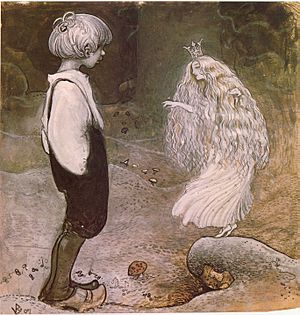
Pictures of fairies have appeared as illustrations, often in fairy tale books, as well as in photographs and sculpture. Some artists famous for their fairy pictures include Cicely Mary Barker, Arthur Rackham, Brian Froud, Alan Lee, Amy Brown, David Delamare, Meredith Dillman, Jasmine Becket-Griffith, Warwick Goble, Kylie InGold, Ida Rentoul Outhwaite, Myrea Pettit, Florence Harrison, Suza Scalora, Nene Thomas, Gustave Doré, Rebecca Guay and Greta James.
The Fairy Doors of Ann Arbor, MI are small doors built into local buildings. Children in the area believe these are the front doors of fairy houses. Sometimes, tiny furniture, dishes, and other small items can be seen behind the doors.
The Victorian era was especially known for fairy paintings. The Victorian painter Richard Dadd created paintings of fairy-folk with a dark and evil feeling. Other Victorian artists who painted fairies include John Atkinson Grimshaw, Joseph Noel Paton, John Anster Fitzgerald and Daniel Maclise. Interest in fairy art had a short comeback after the Cottingley Fairies photographs were published in 1917. Many artists then started painting fairy themes.
Images for kids
-
Title page of a 1603 reprinting of Daemonologie
-
Illustration of a fairy by C. E. Brock
-
Prince Arthur and the Faerie Queene by Johann Heinrich Füssli (c. 1788); scene from The Faerie Queene
See Also
 In Spanish: Hada para niños
In Spanish: Hada para niños



